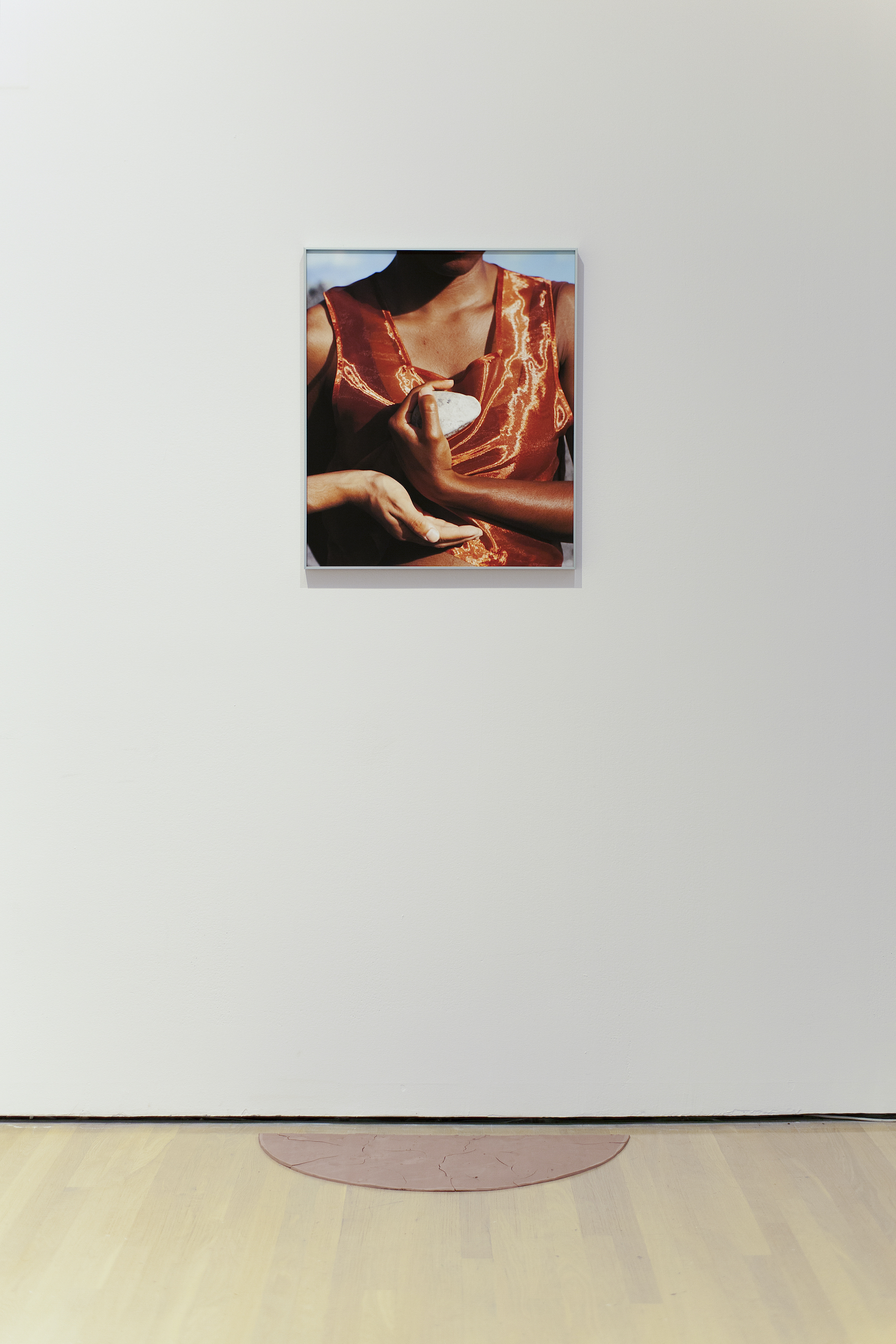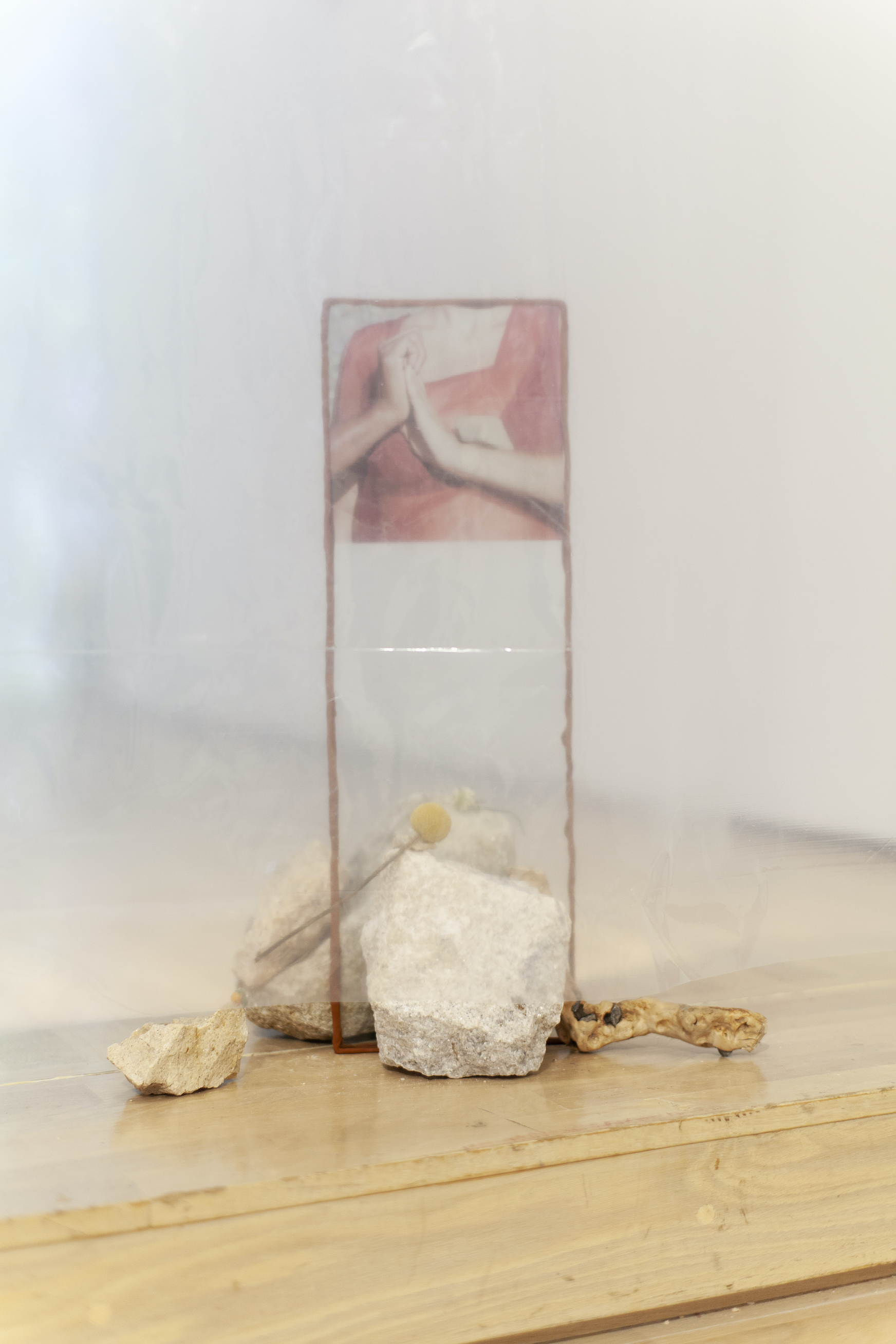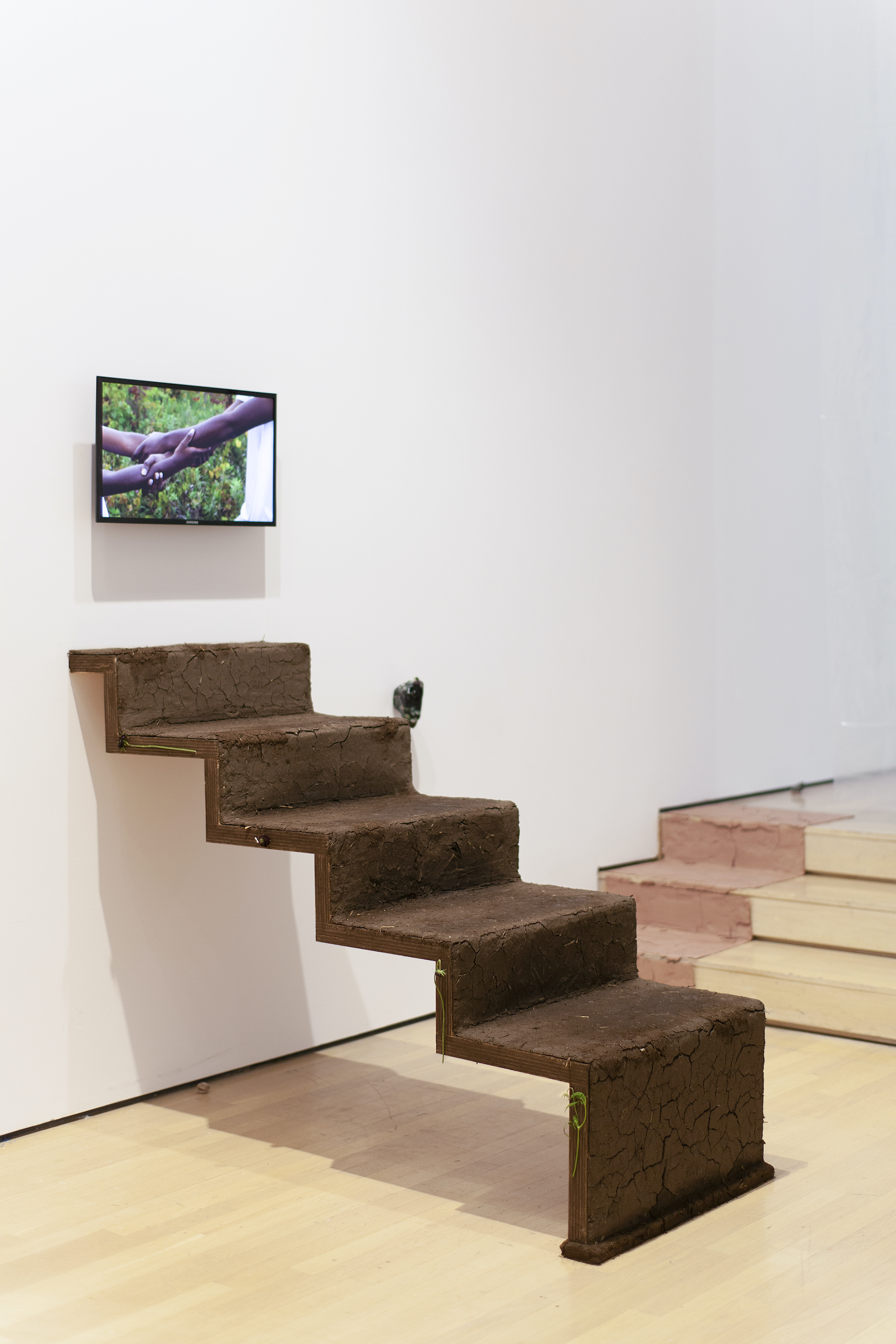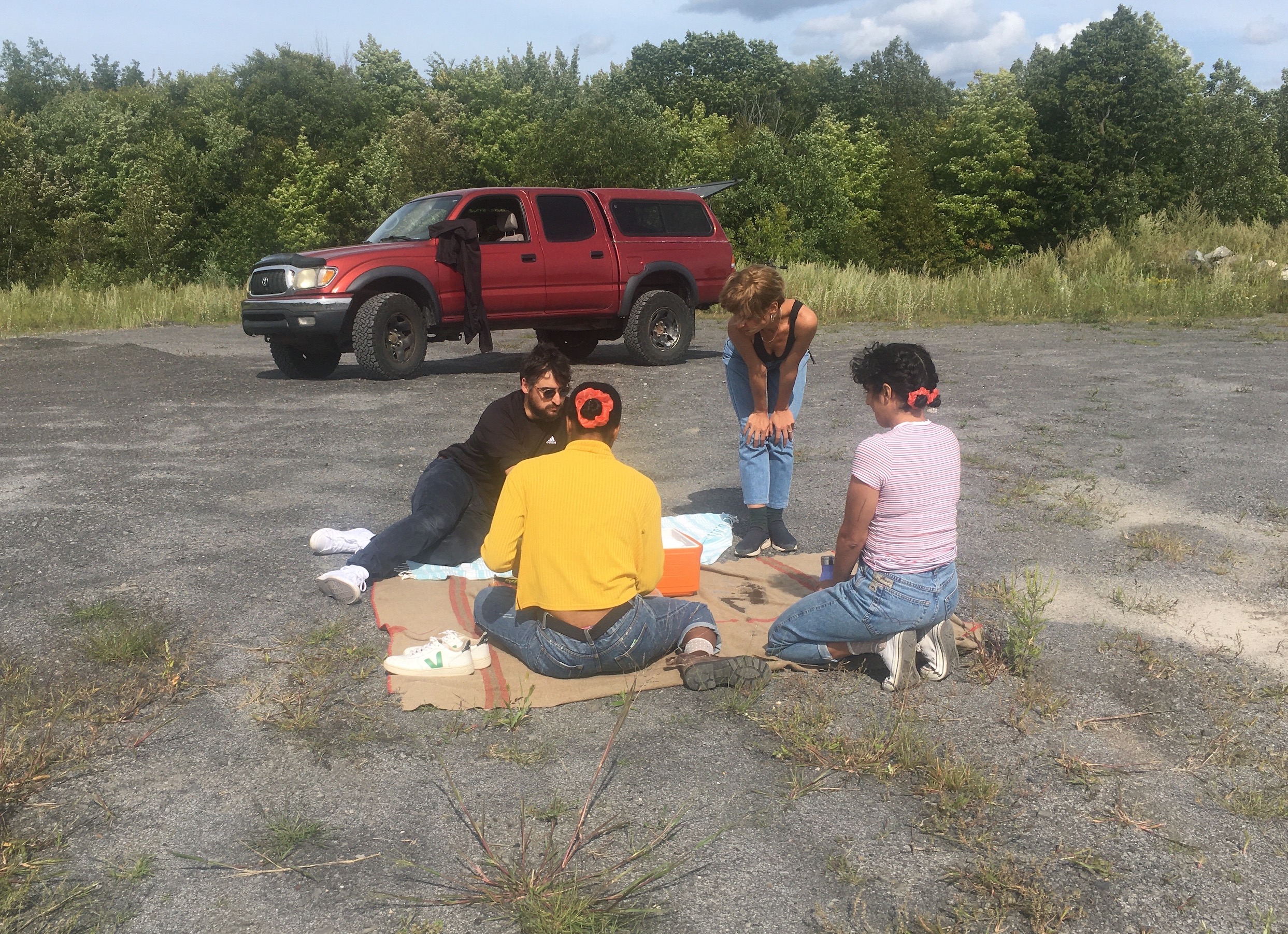Eve Tagny

Eve Tagny. Performance rehearsal (Processions).
2020.



Eve Tagny. Gestures for a Mnemonic Garden.
Installation details. 2020.

Eve Tagny. Gestures for a Mnemonic Garden. Installation view. 2020.
Musée d’Art Contemporain de Montréal. Photos: Simon Belleau
BIOMASS: Could you describe the ideation and research for the exhibition Gestures for a Mnemonic Garden, where did these ideas originate?
Eve Tagny: It was a continuation of investigations around the correlations between bereavement processes and natural spaces. Viewing the cycles of nature as a way of realigning broken rhythms when dealing with Post Traumatic Stress Disorder. My work has recently been concerned with looking at certain aspects of grief, especially grief attached to trauma. There is an obsessive nature to it, in a sense trauma is a disruption of the natural cycle of the self; it’s created by an event that we’re unable to process, therefore our brain keeps replaying it over and over in order to process it, causing all sorts of malfunctions and side effects in the process. Therefore, these are all manifestations of that broken link.
B: And how did the work progress from there into installation work and video works?
ET: I’ve been exploring acts and gestures of ritual as means to process traumas and mend disruptions, anchoring those actions within rhythms of nature, like the seasons - which we can’t rush. It’s like this strong all encompassing force to realign with. So for this show I was trying to broaden the notion of grief in my work, considering ways to situate it, form it and frame it. I created three new videos and framed them into an installation that I approached as a garden containing all the acts and gestures of memorialization enacted in the videos. Each performance or movement in the videos have their own flow and rhythms, but they co-exist simultaneously and inform one another. I view the temporality of the garden the same way: a space of constant transformation, from growth to decay; death is not a finite process if it’s in perpetual flux. That’s why I had recourse to the architecture of the garden: stairs, arches, paths of soil… In the first video, I’m doing healing hand gestures and repeating in a loop “These are the hands that held you while you were hanging from the rope you tied”. These hand gestures come back, performed in unison. In the second video I developed a performance throughout the summer with two performers, Elisabeth-Anne Dorléans and Florencia Sosa Rey. The last video, I shot with my two youngest brothers who were very compliant (smiles and laughs). I wanted to include that image of the young black boy; it's about transferring the healing energy of the second video and opposing toxic masculinity and allowing space for vulnerability in their lives. To me it's meaningful to have those figures because it’s about creating environments that are less oppressive for those beautiful young black kids, you know? That's sort of the rundown of the show.

Eve Tagny. Brothers.
Film photography. 2010.
B: There is a performed procession and set of movements in the main video Summer [gesture to reignite fossilized landscapes]. What ideas and gestures informed these choreographies?
ET: We worked on the idea of lifting weights and working with processions, ritual and movement. Thinking about different aspects of collective grief, I looked into processions, as a way to catalyze change. Walking to materialize our wills or desires, desires for change or to materialize internal conflict. Like pilgrims walking to expiate sins for instance. And then we had the waves of protest for Black Lives Matter here in Montreal. Going down in the streets to walk together to protest, this is a form of procession as well in my eyes. It oftens plays out in this sort of expected choreography: walking towards an end point, the pushback that awaits us, and then often there’s a confrontation between the people and forces of oppression, and then fragmentation, dispersion. So in the work we are sometimes walking, carrying weighty stones, sometimes splitting up and sometimes coming together, which was kind of symbolising what is often unseen, walking through everyday life as people of colour and Black womxn.

Eve Tagny. Performance rehearsal (Processions).
2020.
B: I like how you contextualize the things that have been happening recently in your own life with broader social changes like the Black Lives Matter movement amidst a pandemic, through the lens or frameworks of garden and procession, I think it's phenomenally poetic.
ET: There's something about when I was in those protests that touched me particularly because my personal experience growing up in Montreal is one where racism is almost invisibilized. To suddenly be amongst so many Black people (smiles) and be able to share all those intimate, everyday tiny griefs that we carry and usually don’t express because we have to: hold onto our job or a complicated friendship. And it was interesting for this to happen while [in covid] everything has stopped, all these underlying things could all come out at this moment that made space for it. Allowing those griefs to come up, in procession, walking together, being together, is very important because it makes space for vulnerability. And I think if we don’t make space for vulnerability we are not going to get anywhere!
B: It makes me think of the sometimes impenetrability of whiteness to take on the weight of racism and grief. It sort of connects to the way you were talking about the compartmentalization of grief, that we want to assume that when terrible things happen, they happen in a fixed time and then you're supposed to move on. So the question becomes - how is it moving on if everything is exactly the same for everyone? That seems like the opposite of moving on. Part of that change may involve letting things go, or letting things die.
ET: Hmm yeah. Interesting, I hadn’t heard it said in that way before. I like the idea of having to let certain things die.
B: I became familiar with your work through photography, now you're working more with video and performance. What skill sets or formal training have informed your practice?
ET: My formal training was in film production but to be perfectly honest, I felt like the weight of making film was too much, (laughs) like, how it works. Photography feels like more of a direct and accessible relationship. So I eventually took a path that was more focused on individual work and video re-entered my life as I started doing more exhibition and installation work and I’ve just been trying to expand as I go.

Performers having lunch during video shoot.
2020.
2020.
B: How did it feel to collaborate and work with these performers?
ET: That was a really beautiful and fruitful collaboration. Florencia’s practice is more anchored in performance. I wanted to work with her again after our first collaboration for Gallery44. I was looking for at least another person because I wanted a group dynamic and I came across Élisabeth’s work this way. They all brought different skills and knowledge, the process is more like developing a relationship as well.
B: Do you think you will continue working in this way?
ET: I’m definitely more interested in working collaboratively in the future, like breathing new air in. I’ve explored extensively certain ideas and forms and I feel like I need to find ways to expand and get out of my comfort zone, find new ways of accessing and sharing knowledge. Since the pandemic, a lot of that is happening through fruitful conversations.
Eve Tagny is a Tiohtià:ke/Montreal-based artist. Her practice focuses on the correlations between the bereavement process and nature’s rhythms, cycles, forms and materials, that serve as the ultimate guides for renewal. Navigating between writing, photography, video and installation, her work explores the various pathways of resiliency adopted by culturally hybrid communities in order to free themselves of colonial and patriarcal heritages and formulate sustainable futurities.
